


xxxxxThe Devonian Francis Drake went to sea as a young lad, and learnt his seamanship aboard small coastal vessels. A relative of the navigator John Hawkins, in 1566 he sailed to the West Indies where he was lucky to survive an attack by a Spanish squadron. He returned in 1572, and carried out a successful plundering expedition against Spanish shipping and colonies. It was in 1577 that he began his epic voyage and became the first Englishman to circumnavigate the globe. He passed through the Magellan Straits, crossed the Pacific and Indian Oceans, and returned via the Cape of Good Hope, plundering all the way. He arrived in England in 1580 with an immense fortune in precious stones and spices, but only one of his five vessels, his own ship the Golden Hind, completed the voyage. He was knighted on his return, and served as a Member of Parliament in the 1580s.Then, after yet another voyage to the Spanish Main and a daring attack upon the Spanish fleet in Cadiz harbour, he took a leading part in the defeat of the Spanish Armada in 1588. But later expeditions proved less successful and it was during one of these, an attack on Puerto Rico, that both he and Hawkins died of a fever.
FRANCIS DRAKE
c1540 -
Acknowledgements
Drake: watercolour
by the English miniaturist Nicholas Hilliard (c1547-
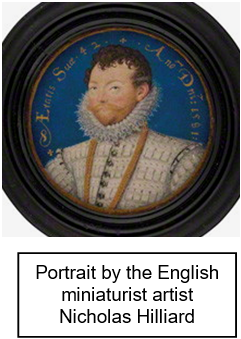 xxxxxThe buccaneer and explorer Francis Drake, the most
famous seaman of the Elizabethan age, was born near Tavistock in
Devon. His father was a tenant farmer and a Protestant lay-
xxxxxThe buccaneer and explorer Francis Drake, the most
famous seaman of the Elizabethan age, was born near Tavistock in
Devon. His father was a tenant farmer and a Protestant lay-
xxxxxIn
1566, as a relative of the celebrated navigator John Hawkins, he
took part in an expedition to the West Indies and, the following
year, was given the chance of commanding his own ship, The
Judith. The aim of the voyage was a slave-
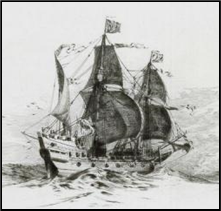 xxxxxAfter serving for three years in Ireland, helping to
put down the rebellion of James Fitzgerald, he was personally
commissioned by the Queen to attack the Spanish colonies which had
been established along the Pacific coast of the New World. He was
well suited for the task. His expedition set out from Plymouth in
December 1577, made up of five ships and about 160 men. Having
crossed the Atlantic, two of the supply vessels were abandoned in
the estuary of the Rio de la Plata in South America. The remaining
three managed to pass through the Straits of Magellan, a voyage of
sixteen days, but were then blown off course by a sudden storm. One
ship was lost and another returned to England, believing that the
expedition had been abandoned. Only Drake's flagship, the Golden
Hind, survived, but there was no thought of turning back.
xxxxxAfter serving for three years in Ireland, helping to
put down the rebellion of James Fitzgerald, he was personally
commissioned by the Queen to attack the Spanish colonies which had
been established along the Pacific coast of the New World. He was
well suited for the task. His expedition set out from Plymouth in
December 1577, made up of five ships and about 160 men. Having
crossed the Atlantic, two of the supply vessels were abandoned in
the estuary of the Rio de la Plata in South America. The remaining
three managed to pass through the Straits of Magellan, a voyage of
sixteen days, but were then blown off course by a sudden storm. One
ship was lost and another returned to England, believing that the
expedition had been abandoned. Only Drake's flagship, the Golden
Hind, survived, but there was no thought of turning back.
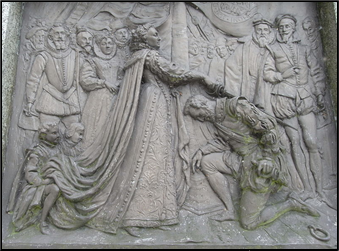 xxxxxDrake now sailed north along the western seaboard of
America, attacking Spanish merchantmen and plundering Valparaiso and
other Spanish ports along the way. The treasure he amassed in gold,
silver and precious stones was immense. Reaching California, he put
in for repairs in a sheltered inlet just north of present-
xxxxxDrake now sailed north along the western seaboard of
America, attacking Spanish merchantmen and plundering Valparaiso and
other Spanish ports along the way. The treasure he amassed in gold,
silver and precious stones was immense. Reaching California, he put
in for repairs in a sheltered inlet just north of present-
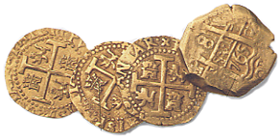
xxxxxIn
1585, on the orders of his Queen, he was off again to attack Spanish
settlements in the West Indies. With a fleet of 25 ships, he first
raided Vigo in Spain and then crossed the Atlantic to plunder
Cartagena and Santo Domingo. The following year he destroyed St.
Augustine in present-
xxxxxDrake's
second claim to fame, of course, is the part he played in the defeat
of the Spanish Armada. Even before the Spanish attack of 1588, Drake
had, as he put it, "singed the King of Spain's beard" in April 1587
by his daring attack on the Spanish invasion fleet assembled in
Cadiz harbour. On that occasion his fleet of 23 ships destroyed some
10,000 tons of shipping and supplies, and put back 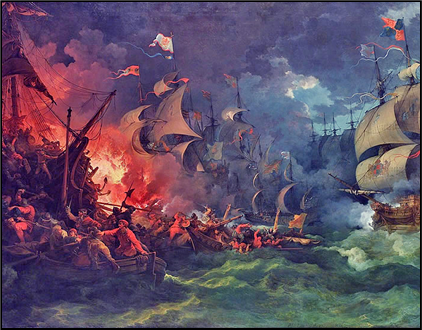 the
threat of invasion for a year. When the Spanish invasion fleet did
arrive off the southern coast of England, popular history would have
us believe that, after finishing his game of bowls on Plymouth Hoe,
he led the English attack against the Armada, possibly single-
the
threat of invasion for a year. When the Spanish invasion fleet did
arrive off the southern coast of England, popular history would have
us believe that, after finishing his game of bowls on Plymouth Hoe,
he led the English attack against the Armada, possibly single-
xxxxxUnfortunately, Drake's later voyages never met with the same success. In 1589 he led an attack upon the few remaining ships of the Spanish Armada but achieved little. Then, together with Sir John Norris, he led a large expedition of 150 ships and 18,000 troops to Portugal in an attempt to place Don Antonio on the Portuguese throne. They managed to destroy Corunna, but failed to take Lisbon, and the expedition had to be abandoned when sickness broke out among the troops.
xxxxxIn 1595, together with Hawkins, Drake sailed from Plymouth on his last expedition to the Spanish Main. The fleet of 27 ships took the town of Puerto Rico, but failed to gain control of the harbour. Hawkins died of a fever during this action and, because of serious sickness aboard many of the vessels, it was decided to return home. It was while sailing off the town of Puerto Bello (modern Portobello) in January 1596 that Drake died, also of a fever. It is perhaps fitting that this great English seafarer was buried at sea, in the waters where he had achieved so much success and notoriety.
xxxxxIncidentally, as one would expect, many poems have been written
concerning the exploits of Sir Francis Drake. Three must suffice. Inx1598 The Spanish poet and
playwright Lope de Vega, who served in the Armada, wrote Dragontea,
a verse history of Drake's last voyage and death; and the English
poet Sir Henry Newbolt
(1862-
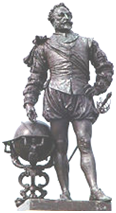
Drake he was a Devon man, an' ruled the Devon seas,
(Capten, art tha sleepin' there below?),
Rovin' tho' his death fell, he went wi' heart at ease,
An' dreamin' arl the time o' Plymouth Hoe.
"Take my drum to England, hang et by the shore,
Strike et when your powder's runnin' low;
If the Dons sight Devon, I'll quit the port o' Heaven,
An' drum them up the channel as we drummed them long ago.
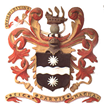 xxxxxAnd an anonymous poet
wrote of his death at sea:
xxxxxAnd an anonymous poet
wrote of his death at sea:
The waves became his winding sheet; the waters were his tomb;
But for his fame, the ocean sea was not sufficient room. ……
xxxxx…… Though regarded as a hero
by his fellow countrymen -
L1-


